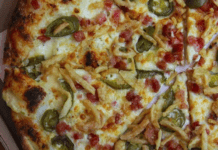Written By: Lindsay Forsey
[dropcap size=big]C[/dropcap]omfort foods, deconstructed classic desserts and artisanal ice cream are a few of the top trends listed in the “Restaurants Canada 2014 Chef Survey,” conducted by Toronto market research firm BrandSpark and based on responses from more than 400 professional chefs across the country. The icing on the cake? People are most willing to pay more for made-from-scratch desserts tied to quality and nostalgia, according to “The Canadian Dessert Consumer Trend Report 2013,” published by Chicago-based research firm Technomic. Plus, nearly 40 per cent of consumers surveyed are seeking the desserts they enjoyed as children.
“People are embracing rustic baking and warming comfort food that is meant to be shared,” confirms Andrew Winfield, executive chef at Calgary’s River Café. “A great dessert evokes a memory. Our version of a s’more, for example, reminds people of sitting around a campfire roasting marshmallows.” The Wood-Fired Oven Kahlua-and-Espresso S’more ($3) is made with organic dark chocolate and a hand-crafted graham cookie. All desserts are made in-house at River Café, including the dozen-or-so
ice creams and sorbets ($10) on offer, featuring flavours such as maple corn and anise hyssop.
Winfield describes his customers as knowledgeable foodies seeking well-rounded meals and often this means saving room in their stomachs, and their wallets, for dessert. “When a dessert is made from scratch using local, in-season ingredients, people feel good about indulging,” he says. River’s bestselling desserts include anything chocolate and all things salted caramel, reflecting another prominent trend noted in the “2014 Chef Survey.” The Maple Wild Rice Pudding ($11) with huckleberry compote and citrus lace cookies is a signature favourite, as is the seasonal Warm Pumpkin Sticky Toffee Pudding ($11), on the menu throughout fall and winter and served with spiced crème fraiche.
“We source local wild rice from northern Alberta and infuse the pudding with maple syrup, cinnamon, star anise and vanilla,” Winfield says. Diners anticipate these belly-warming delights. “We encourage a well-balanced enjoyment of dinner, including something sweet. It’s good to remind people about dessert before the end of the meal,” he says. River Café’s dessert prices have increased only slightly over the past 15 years, from an average of $8 to $10 up to an average of $10 to $11. “I think prices are due for a more significant increase. The dishes are profitable, but many of the products we use are pricey,” he says. “We make sure the sales are there to make it work.”
While desserts aren’t the most profitable menu items, they are essential. At Toronto-based Oliver & Bonacini Restaurants (O&B), the last bites of a meal are never an afterthought. “Understanding the importance of the whole meal is huge,” says Anthony Walsh, the O&B corporate executive chef, who oversees the menus at the company’s 12 restaurants, which range from casual cafés to top fine-dining establishments. “Costs have come up over the past few years. The days of the $7 dessert are gone, and you’re not going to make a ton of money on it, but dessert is the happy ending to a great experience, and we bust our humps to make that happen.”
Over the past few years some O&B restaurants have been leveraging sales by offering a selection of teeny desserts, such as a two-tablespoon-sized crème brûlée or a cheesecake lollipop. “Small-portion desserts are not as indulgent as having the giant slice of molten chocolate cake,” Walsh says. “A lot of people want just a small treat at the end of their meals.” Tiny desserts aside, other popular O&B sweets include Jump Restaurant’s Artisan White Chocolate Cheesecake ($9), double-baked in phyllo pastry with biscotti crust and its Chocolate Layer Cake ($9), a decadent wedge made for two, served with icy-cold milk.
O&B desserts are made in-house at individual restaurants or supplied by the company’s bakery (not open to the public). It churns out take-away items, such as cookies, for the company’s more casual eateries and handles all off-site catering. “We’ve been operating our bakery for four-and-a-half years now. It’s incredible to have complete control over production,” says Walsh, who is tuned in to the trend toward nostalgic desserts. “Customers are looking for tried-and-true classics, like pies and cobblers. The approachability factor is big right now,” he says.
Incorporating hearty grains, such as kamut, buckwheat, millet and amaranth into desserts is another trend noted on the “2014 Chef Survey,” as well as at O&B. “We always have customer welfare in mind, but we aren’t necessarily including more grains for health reasons. It’s more about exploring flavours and textures,” Walsh says. “Dessert has to have elements of fun, naughtiness and inventiveness. It’s about those curious people in the back who create stuff that makes people smile.”
One of those folks in the back is Robert Gonsalves, the pastry chef at O&B’s upscale Canoe, who is creating a fall dessert made with rye and apples and something new for the Chef’s Menu using balsam fir. Canoe’s most popular desserts include its Chocolate Torte and Classic Canoe Butter Tart ($12 each). “A good dessert is about balance,” he says. “You want something that is rich and acidic and texturally interesting.”
The trend toward familiar desserts is apparent across foodservice segments. At Swiss Chalet Rotisserie and Grill, a Vaughan, Ont.-based Cara Operations’ brand, the dessert menu is focused on pie and ice cream. “Dessert has to fit with our vision of offering uncomplicated comfort food done right. It should bring you to a place of good memories,” says Lindsay Robinson, Swiss Chalet’s director of Marketing. The brand makes some desserts in-house, while others are sourced from unnamed suppliers. Robinson explains that shareable items are popular choices: “Gone are the days of heavy, decadent desserts for one person,” she says.
The trend towards smaller indulgences is also influenced by cost. According to Technomic’s report, dessert remains a price-sensitive add-on where affordability and value are key purchase drivers at both limited- and full-service restaurants. Swiss Chalet’s bestselling dessert — its signature stuffed doughnuts ($6 to $7) — hits the spot for both portion size and price point. “Guests want the indulgence, just less of it,” Robinson says. “They also want something they wouldn’t necessarily make at home.”
During the past few years, doughnuts have experienced a revival, appearing on restaurant menus and inspiring new businesses dedicated to the old-fashioned treat. Calgary’s Jelly Modern Doughnuts, co-owned by siblings Rita and Rosanne Tripathy, opened its first location in April 2011. Since then, the brand, applauded by Martha Stewart and Oprah Winfrey, has launched a food truck in Calgary and a shop in Toronto as well as kiosks inside Pusateri’s, Toronto-based gourmet food shops. Jelly will open another location in Toronto’s financial district this fall with plans to hit Vancouver next.
The doughnut-centric operation is capitalizing on trends towards bite-sized portions, wholesome ingredients, budget-friendly choices and traditional feel-good indulgences. Jelly offers a three-bite doughnut ($2.25) and a regular-sized rendition ($2.75) with flavours such as Classic Jelly, Callebaut Chocolate and Maple Bacon rounding out the bestsellers list. (Bacon is yet another dessert trend noted on the “2014 Chef Survey.”) The monthly feature doughnut has included the London Fog, with a chai tea-infused glaze, whipped cream and sprinkles, and the Cherry Cobbler, stuffed with cherry pie filling, then topped with cinnamon and streusel.
Jelly has introduced more than 150 varieties since opening. “There’s so much you can do with a doughnut,” says head pastry chef, Atul Palghadmal, who stresses that the doughnuts are made from scratch, contain no additives or preservatives and include local, seasonal ingredients when possible. “People have a love-hate relationship with the doughnut,” he says. “They don’t see it as a healthy option, but it’s such a good sweet.”
Catering and events make up a significant portion of Jelly’s business, with corporate clients ordering customized flavours, brides choosing something more whimsical than cake and parents spoiling kids on birthdays. “Jelly doughnuts are something you can display on a dessert table and really make a beautiful impression,” Palghadmal says. “That’s not something you could always say about doughnuts.” With more than 8,000 Twitter followers, Jelly’s success proves that the doughnut remains a sought-after sweet. Twenty years from now, people will still get that warm, fuzzy feeling reminiscing about the chewy, circular delight, albeit with a more modern twist than the Hawaiian Sprinkle of days past.

















